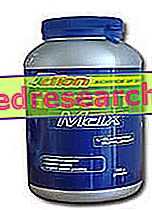
Information on Glutam Max - PROACTION
Glutam Max - PROACTION
Food supplement based on L-Glutamine powder
FORMAT
300 gram jar
COMPOSITION
l-Glutamine soluble powder
Measuring cup: L-Glutamine: 1.75 grams
NOTE: l-glutamine contained in Glutam Max is a Degussa product and meets all the requirements of the Food Chemical Codex, Fourth Edition (National Academy Press, Washington DC 1996).
Product features Glutam Max - PROACTION

L-Glutamine - It is synthesized in various tissues, particularly in the muscular tissue, starting from glutamate and ammonia, in the presence of the enzyme glutamine synthetase. Glutamine is the most abundant free amino acid in the human body.
Defined as a NON ESSENTIAL amino acid, its dietary intake can become indispensable in cases of greater need, which occur during intense training or serious pathological conditions (severe trauma, burns, etc.).
The high plasma concentrations of glutamine fully reflect the key role of this amino acid in human metabolic balance, since it falls:
- In the transport of amino groups, necessary for protein synthesis;
- In the transport of amino groups, intended for the elimination in the form of urea;
- In the synthesis of other amino acids, such as arginine;
- In the synthesis of powerful antioxidants such as glutathione;
- In the energetic and excitatory action at the level of the central nervous system;
- In energy processes, representing a useful source both in the gluconeogenesis process and in the supply of the krebs cycle.
- In the processes of cell division of cells with rapid turn-over (immune system cells, intestinal cells and hematopoietic stem cells);
Potential benefits for sports use Glutam Max - PROACTION
It is now known that this amino acid is affected by intense physical activity, dropping dramatically following periods of vigorous training. The important drop in glutamine (a source of primary importance for leukocyte survival) inevitably has repercussions on the athlete's state of health, significantly reducing the immune defenses and facilitating the onset of bacterial and viral infections, thus compromising their physical and mental capacities . This condition, along with other more well-known ones, such as chronic fatigue and hormonal deregulation, define a picture known to many sportsmen: overtraining. In this case the glutamine suppementation has been shown to be effective in several studies, increasing leukocyte survival, regulating lymphocyte levels, and protecting the athlete from the attack of pathogenic microorganisms, even if the molecular mechanisms remain to be clarified.
However, glutamine is used in sports with the aim of obtaining other results:
- Facilitate recovery : this hypothesis is supported by studies showing an increase in stocks of muscle glycogen by 25% following training with carbohydrate supplementation and 8 g of glutamine. However, this has been followed by other studies that deny these results and show a greater benefit in terms of recovery, with a balanced post-workout meal.
- Improving performance: the scientific literature seems to agree in considering the absence of ergogenic effects following the administration of glutamine alone;
- Increasing the lean mass : positive results were obtained following association of glutamine with BCAA and carbohydrates.
- Reduce the catabolic effects of intense training: the only evidences derive from a study that shows the plasma reduction of the enzyme creatinkinase, in the group treated with glutamine, following physical exercise;
- Increase GH secretion : a 1995 study shows a 4-fold increase in GH, compared to the control, after taking 2 grams of glutamine. However, it is necessary to clarify the absence of subsequent confirmations and the fact that intense training can increase the plasma levels of this hormone as much as 20 times, independently of glutamine supplementation.
To this it should be added that a large part of the free glutamine taken orally is metabolized in the intestinal cells, with a consequent lowering of its bioavailability. Studies show that a greater plasma increase in this amino acid can be achieved in overtraining syndromes, simply by introducing 20/30 grams of protein in post-training.
Recommended use by the company - Glutam Max - PROACTION
Dissolve 1 measuring scoop of 1.75g in water or other beverage. Drink once a day or as needed.
Use in sports practice Glutam Max - PROACTION
The scientific literature is still far from defining an optimal dosage of this amino acid, especially for applications in the sports field, which have been discussed.
In common practice very high doses are assumed, which exceed even 20 grams, and which, as far as can be seen from the scientific world, do not seem to be particularly useful. Positive results in terms of post-workout muscle recovery and protective action were obtained with significantly lower dosages, between 2 and 8 grams per day (the same amount that would be obtained for a 70 kg man who consumes 0.8 / 1.6 gr of protein per kg of body weight).
Given the powder formulation, it should be pointed out that solubilization in water or other liquid seems to facilitate the intestinal diffusion mechanism of this amino acid, provided it is consumed quickly by its preparation.
On the basis of little scientific evidence, pre-workout administration could be used to increase the glutamine pull by supplying the muscular one, and in post-training as an adjunct to the anabolic window.
How to optimize your business - Glutam Max - PROACTION
From the various studies emerges as the association of
Glutamine + BCAA + Protein causes an increase in lean mass after weeks of integration and heavy exercise;
Glutamine + carbohydrates, taken in the post-work-out anabolic window, can facilitate glucose uptake and glycogen resynthesis; taken before intermittent training, they seem to improve athletic performance and reduce the feeling of fatigue.
Glutamine + creatine + ribose, does not seem to provide particular benefits in terms of body composition variation.
Glutam Max - PROACTION side effects
Several studies have experimented supplementation with doses of oral glutamine even greater than 20 grams, without registering any particular side effect.
A single long-term study, with athletes taking doses of 28 grams per day for 2 weeks, distributed in 4 different assumptions, showed no side effects.
Precautions for use Glutam Max - PROACTION
The product is contraindicated in cases of renal or hepatic disease, cardiovascular disease and / or hypertension, during pregnancy, during lactation, under 12 years and in adolescents not yet trained.
In the event of prolonged use (over 6/8 weeks), medical advice is required.
This article, elaborated on the critical re-reading of scientific articles, university texts and common practice, is for informational purposes only and is therefore not a medical prescription. It is therefore always necessary to consult your doctor, nutritionist or pharmacist before starting to use any kind of supplement . Further information on the critical analysis of Glutam Max - PROACTION.
| BIBLIOGRAPHY |
Kingsbury KJ, Kay L, Hjelm M. Contrasting plasma amino acid patterns in elite athletes: association with fatigue and infection. Br J Sports Med. 1998; 32: 25-33 Regul Toxicol Pharmacol. 2008 Apr; 50 (3): 376-99. Epub 2008 Jan 26. Risk assessment for the amino acids taurine, L-glutamine and L-arginine.Shao A, Hathcock JN. Clinical use of glutamine supplementation. Wernerman J. J Nutr. 2008 Oct; 138 (10): 2040S-2044S. Review. L-glutamine supplementation induces insulin resistance in adipose tissue and imprints insulin signing in the liver and muscle of rats with diet-induced obesity. Prada PO, Hirabara SM, de Souza CT, Schenka AA, Zecchin HG, Vassal J, Velloso LA, Carneiro E, Carvalheira JB, Curi R, Saad MJ. Diabetologia. 2007 Sep; 50 (9): 1949-59. Epub 2007 Jun 29. Effect of physical activity on glutamine metabolism. Agostini F, Biolo G. Curr Opin Clin Clin Metab Care. 2010 Jan; 13 (1): 58-64. Review. Peptide glutamine supplementation for soccer players. Favano A, Santos-Silva PR, Nakano EY, Pedrinelli A, Hernandez AJ, Greve JM. Clinics (Sao Paulo). 2008 Feb; 63 (1): 27-32. Glutamine supplementation prevents exercise-induced neutrophil apoptosis and reduces p38 MAPK and JNK phosphorylation and p53 and caspase 3 expression. Lagranha CJ, Hirabara SM, Curi R, Pithon-Curi TC. Cell Biochem Funct. 2007 Sep-Oct; 25 (5): 563-9. Impact of glutamine supplementation on glucose homeostasis during and after exercise. Iwashita S, Williams P, Jabbour K, Ueda T, Kobayashi H, Baier S, Flakoll PJ. J Appl Physiol. 2005 Nov; 99 (5): 1858-65. Epub 2005 Jul 21. Effects of effervescent creatine, ribose, and glutamine supplementation on muscular strength, muscular endurance, and body composition. Falk DJ, Heelan KA, Thyfault JP, Koch AJ. J Strength Cond Res. 2003 Nov; 17 (4): 810-6. Nutrition. 1997 Jul-Aug; 13 (7-8): 738-42. The effects of oral glutamine supplementation on athletes after prolonged, exhaustive exercise. Castell LM, Newsholme EA. Lack of functional benefit with glutamine versus placebo in Duchenne muscular dystrophy: a randomized crossover trial. Mok E, Letellier G, Cuisset JM, Denjean A, Gottrand F, Alberti C, Hankard R. PLoS One. 2009; 4 (5): e5448. Epub 2009 May 6 Glutamine protects against increases in blood ammonia in football players in an exercise intensity-dependent way. Bassini-Cameron A, Monteiro A, Gomes A, Werneck-de-Castro JP, Cameron L. Br J Sports Med. 2008 Apr; 42 (4): 260-6. Epub 2007 Nov 5. Effect of glutamine supplementation combined with resistance training in young adults. Candow DG, Chilibeck PD, Burke DG, Davison KS, Smith-Palmer T. Eur J Appl Physiol. 2001 Dec; 86 (2): 142-9. Cell Biochem Funct. 2010 Jan; 28 (1): 24-30. Cruzat VF, Rogero MM, Tirapegui J. L-glutamine supplementation induces insulin resistance in adipose tissue and imprints insulin signing in the liver and muscle of rats with diet-induced obesity. Prada PO, Hirabara SM, de Souza CT, Schenka AA, Zecchin HG, Vassal J, Velloso LA, Carneiro E, Carvalheira JB, Curi R, Saad MJ. Diabetologia. 2007 Sep; 50 (9): 1949-59. Epub 2007 Jun 29. Am J Physiol Cell Physiol. 2001 Oct; 281 (4): C1259-65. Effect of glutamine supplementation on exercise-induced changes in lymphocyte function.Krzywkowski K, Petersen EW, Ostrowski K, Kristensen JH, Boza J, Pedersen BK. Examination of the efficacy of acute L-alanyl-L-glutamine ingestion during hydration stress in endurance exercise. Hoffman JR, Ratamess NA, Kang J, Rashti SL, Kelly N, Gonzalez AM, Stec M, Anderson S, Bailey BL, Yamamoto LM, Hom LL, Kupchak BR, Faigenbaum AD, Maresh CM. J Int Soc Sports Nutr. 2010 Feb 3; 7: 8. J Strength Cond Res. 2006 Aug; 20 (3): 643-53. Kerksick CM, Rasmussen CJ, Lancaster SL, Magu B, Smith P, Melton C, Greenwood M, Almada AL, Earnest CP, Kreider RB. Appl Physiol Nutr Metab. 2006 Oct; 31 (5): 518-29. Addition of glutamine to essential amino acids and carbohydratesWilkinson SB, Kim PL, Armstrong D, Phillips SM. |



